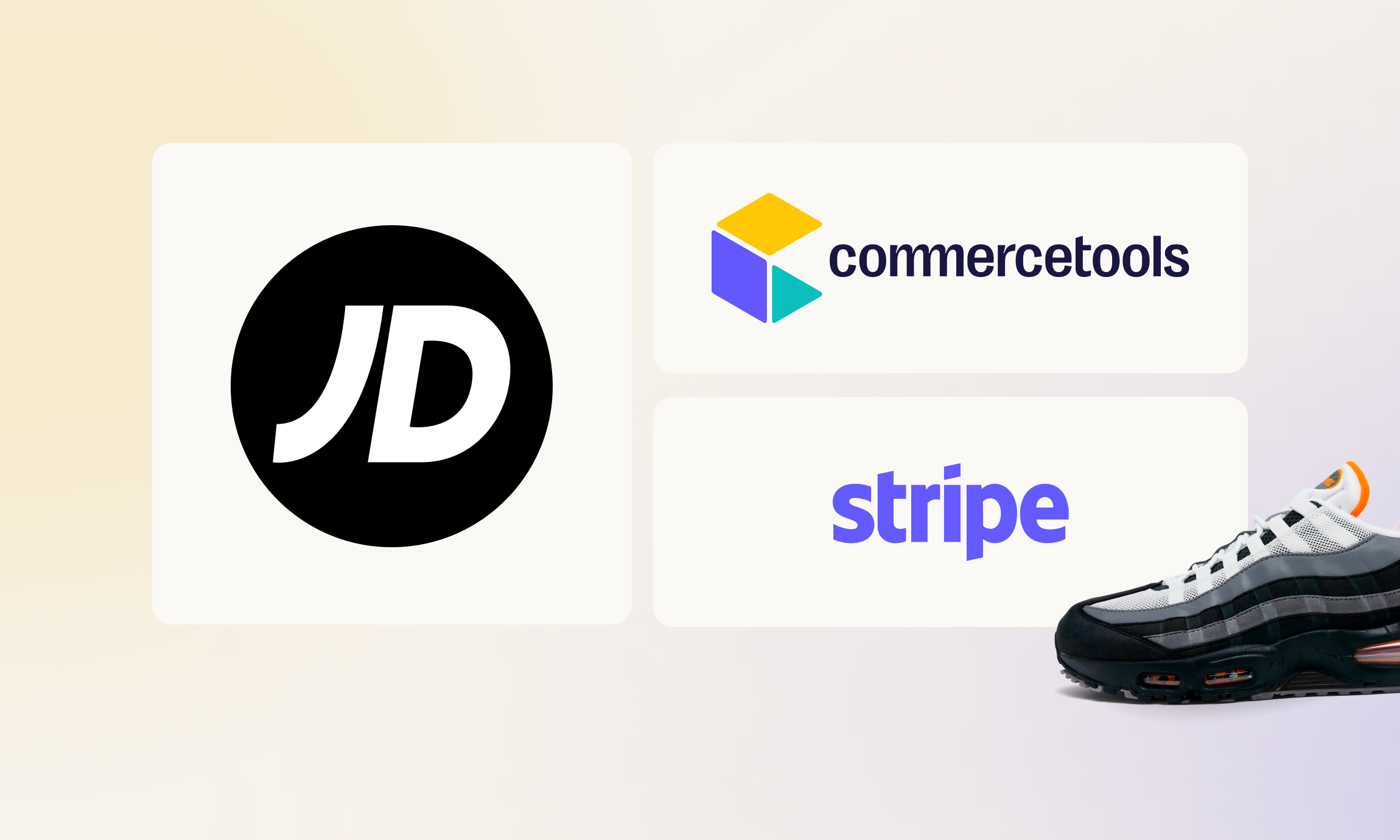Unified commerce. Unlimited growth.
Connect all data in one platform to elevate customer experiences, streamline operations and grow your business. Learn what unified commerce is — and how commercetools is setting the standard.
TALK TO AN EXPERT
Disconnected commerce systems lead to disjointed CX.
Consumers expect smooth, connected journeys, but most tech stacks can’t keep up.
65% of retailers say their systems fall short. Siloed data, high costs and clunky channel handoffs aren’t just operational headaches — they’re barriers to growth and customer loyalty.
The solution? Unified commerce.
What’s unified commerce?
Unified commerce connects all your data — inventory, pricing, product data, customer profiles, loyalty programs and order history — into one platform. The result? Seamless customer experiences across multiple channels, brands, business models and countries.
commercetools is the only unified commerce platform built to handle the “multi-everything” reality. One foundation. Infinite flexibility. Designed to grow with you — and scale whatever comes next.

The results leading enterprises get with unified commerce.
Source: Incisiv
One platform. One single source of truth.
Infinite possibilities.
Infinite possibilities.
Examples of use cases that unified commerce empowers you to implement.
Shoppers can scan or save items in-store and complete the purchase online at their convenience, without starting over. Associates help build carts, capture in-store interest and boost conversion.
Customers enjoy hassle-free, receipt-free returns in-store, with associates accessing full purchase history instantly. Retailers benefit from streamlined operations and improved customer satisfaction.
Shoppers see real-time product availability and get help completing purchases in-store, even for items that require shipping. Associates can retrieve online carts, assist in fulfillment and ensure seamless handoff across channels.
Loyalty points, offers, and personalized pricing follow customers across every touchpoint, automatically applied without friction. Associates access unified profiles to deliver tailored service in-store.
AI stylists recommend complete outfits based on preferences, behavior and inventory, both online and in-store. Associates are empowered with tools and insights to deliver luxury-level personalized service.
Give store associates real-time access to customer data and carts to elevate service and drive sales. Empower them to bridge digital and physical experiences with confidence and consistency.
The Unified Commerce Playbook for Retail Leaders
The practical guide for unified commerce with a comprehensive view of trends, AI-driven impact, use cases, success stories and actionable insights to help brands and retailers get started.

Unlock next-level growth with agentic AI.
Combine real-time, centralized data with AI agents capable of autonomous decision-making to automate complex workflows, personalize experiences at scale and unlock new levels of agility across channels.
Autonomous personalization
Unified data enables AI agents to dynamically tailor content, offers and layouts across touchpoints based on real-time behavior and preferences.
Intelligent fulfillment
With access to accurate inventory and logistics data, agentic AI can automatically reroute shipments, optimize stock levels and reduce delivery times.
Proactive customer service
AI agents use unified customer profiles and order history to detect potential issues before they arise, resolving them without human intervention for a smoother customer experience.
Retail leaders tapping into unified commerce to win.
Many leading enterprises already leverage unified commerce to streamline operations and deliver seamless customer experiences. Here’s how forward-thinking brands are raising the bar through smarter integration with commercetools.
Composable vs. unified commerce: Contradictory or complementary?
The modular nature of composability might seem at odds with unified commerce, but the two concepts are complementary rather than contradictory.
Composable commerce enables companies to plug, customize and integrate best-of-breed solutions. In contrast to rigid, monolithic platforms, a composable approach enables you to adapt features to their needs and swap modules without disrupting the whole system. You can build unified shopping experiences from pre-built components from commercetools and other players — or bring your own — ensuring that all components work together seamlessly.
Composable is the architecture, and unified commerce is the outcome. By combining best-of-breed flexibility with seamless interoperability, retailers gain the freedom to innovate while delivering the cohesive experiences customers expect.
Unified commerce powered by commercetools
commercetools Composable Commerce
Explore:

commercetools InStore
Explore:

Agentic Commerce and co.
Explore:

Frequently asked questions
What are the core components of a unified commerce platform?
At its heart, a unified commerce platform acts as the central nervous system for your business, ensuring data flows smoothly between channels and departments. To achieve this, the right platform should include these key components:
- Centralized data management: Unified commerce relies on a single source of truth for data, giving you real-time visibility into inventory, customer preferences and sales across every channel, eliminating discrepancies and ensuring accurate, up-to-date insights.
- Unified payments: A unified system ensures seamless payment processing across online, in-store and mobile platforms.
- Flexible integrations: Many businesses rely on legacy systems that were not designed to meet the demands of modern commerce. Unified platforms with open architectures allow easy integration of tools and systems, avoiding complete overhauls.
- Scalable architecture: As businesses grow, a unified commerce platform should evolve with them. Scalable systems ensure the technology can adapt to increasing complexity and demand.
What are the main benefits of unified commerce?
Unified commerce offers transformative benefits that go beyond customer satisfaction. Here are the top four ways it makes a tangible difference across multiple areas:
Enhanced customer experience (CX): Unified commerce integrates channels, brands, stores, business models and more to provide a seamless shopping journey.
Operational efficiency: Centralizing processes and automating tasks eliminates redundancies and manual errors. This saves time and reduces costs, allowing teams to focus on strategic initiatives.
Data-driven decisions: Real-time data visibility enables businesses to make informed decisions quickly, from inventory management to marketing strategies, ensuring they can stay ahead of market trends.
Future-proofing: Unified systems are designed to evolve with changing consumer expectations and technological advancements, helping businesses stay competitive in a fast-moving market.
How can unified commerce help reduce operational costs and increase efficiency?
Unified commerce eliminates operational inefficiencies by consolidating processes and enabling streamlined workflows. With centralized operations, tasks like inventory management and order processing become more efficient, reducing redundancies and improving accuracy. Automation plays a crucial role in reducing manual errors and freeing staff for more strategic initiatives.
Additionally, real-time data visibility allows businesses to optimize resource allocation by accurately forecasting demand, preventing overstocking or understocking and minimizing waste. These enhancements help businesses reduce costs while maintaining a scalable and efficient operation.
How can an enterprise prepare for a unified commerce implementation?
Unified commerce is a strategic transformation that impacts your people, processes and long-term growth. Success depends on aligning four critical pillars:
People: Empower frontline workers
Your store associates are more than salespeople — they’re orchestrators of the omnichannel experience.
- Equip them with intuitive, mobile-first tools that surface real-time data.
- Cross-train for agility across fulfillment, sales and service.
- Involve workers in testing new processes and workflow design.
Data and processes: Build consistency and intelligence
Unified commerce thrives on real-time, reliable data and orchestrated workflows.
- Centralize product, customer, inventory and order data.
- Automate end-to-end processes like fulfillment and returns.
- Use AI to transform data into intelligent, proactive actions.
Technology: Lay the right foundation
Rigid legacy won’t support a unified feature — composable, cloud-native tech will.
- Move beyond traditional POS (point of sale) systems.
- Use APIs and event-driven architecture for real-time system integration.
- Adopt a composable stack that evolves with your business. not against it.
Implementation: Start small, scale fast
Don’t try to modernize everything at once. Prove value, then expand.
- Launch MVPs tied to specific use cases (e.g., BOPIS or unified returns).
- Pilot in focused regions to validate performance and gather feedback.
- Design for scale from day one with modular components.
Unified commerce is a journey, and it starts with aligning the right peopl, processes and platforms for success.
What’s the difference between unified commerce and omnichannel commerce?
Omnichannel commerce aims to deliver a consistent customer experience across all touchpoints — whether online, in-store, mobile or social.
Unified commerce connects all backend systems (inventory, payments, customer data and order management) on a single platform. From click-and-collect to real-time inventory visibility and personalized promotions across channels, unified commerce turns omnichannel ambition into operational reality.
In essence, omnichannel is the experience layer — what the customer sees and feels — while unified commerce is the technology foundation that makes it all work behind the scenes.
How can an enterprise integrate existing AI tools with commercetools’ unified commerce platform?
Enterprises can integrate existing AI tools with commercetools’ unified commerce platform by leveraging its API-first, composable architecture. Since commercetools separates frontend and backend capabilities and exposes all commerce functions via APIs, AI tools — such as personalization engines, recommendation systems, chatbots, and demand forecasting solutions — can be seamlessly connected to core data like product catalogs, inventory, customer profiles and order history.
With real-time data access across all channels, AI tools can analyze and act on consistent, up-to-date information, enabling intelligent automation, personalized experiences and smarter decision-making. commercetools also supports integration with leading AI platforms via Commerce MCP, Agentic Commerce and AI Hub.
How can enterprises manage the “multi-everything” approach with unified commerce?
As businesses grow across countries, brands and channels, managing this complexity often leads to a fragmented technology stack. Enterprises frequently adopt different systems for specific regions or brands, which creates inefficiencies, inconsistent customer experiences and higher costs due to duplicated platforms and integrations.
Delivering seamless customer experiences at scale requires a unified yet flexible approach. commercetools enables retailers to manage multiple brands, regions and channels from a single platform using the Stores feature.
With Stores, enterprises can unlock unified commerce by managing centralized data like customers, products, inventory and pricing, while tailoring experiences for specific contexts, such as channels, brands, countries or business models. This structure enables efficient differentiation without duplicating data, ensuring that each store, site or segment delivers the right experience with the right products, prices, and promotions.




